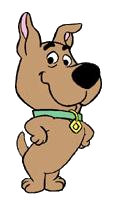Reception
Scrappy was initially seen as a "good idea" by Saturday Morning Review. [18] Viewership seemed to react positively to Scrappy, as Scooby's ratings went up with Scrappy's arrival. The character continued to be a success for the next decade. [19] [20] [21] Story editor Duane Poole noted that "Scrappy solved a lot of story problems. Before you had to get Shaggy and Scooby into dangerous situations—and there was no real easy way to get them there—with Scrappy, he, uh, picked them up and carried them there. He just charged in. He was just such the antithesis of what Scooby and Shaggy were. The dynamic was great fun to play." [22]
Joe Ruby and Ken Spears [23] seemed to have a less-than-positive view of the character. The co-founder of Ruby-Spears enterprises said, "Everyone was upset", though was unclear about whether this concerned business reasons (they had started their own company two years earlier) or personal creative reasons (considering that if Scooby had been canceled, then the last slot would have hit their show instead), [24] starting when, in 1979, it appeared that a pilot of theirs would be renewed over Scooby's. Mark Evanier, who wrote said pilot, was hired impromptu to write Scrappy-Doo into a new pilot to renew interest in Scooby. As a result, Scooby was renewed over theirs, which was upsetting for them. [25] "Scrappy would charge in and solve things, so he was useful, in that way. A lot of people made derogatory comments about it at the studio and you know you don't want to be saddled with something based on, you know, network [...] but I think I liked working with it most of those cartoons," [26] said Charles M. Howell, a writer who originally joined the franchise back on The New Scooby and Scrappy-Doo Show and continued to work on various iterations of the show until finally ending his tenure in the late 1980s after penning the pilot episode for A Pup Named Scooby-Doo . [27]
Tom Ruegger stated: "It's a lot easier to love Scooby than it is to love Scrappy. But I don't have the problem with Scrappy that I have heard expressed by others. I suspect this is because I wasn't watching Scooby from the beginning, but rather, I came in and started catching up quite a while (a couple of years) after Scrappy had made his debut. Hey, they'd been messing with Scooby's cast for years! Scooby Dum. All those nasty celebrity cameo Scooby movies. I dislike those things more than I dislike Scrappy. And, for what it's worth, at least Scrappy brings some energy to the table. He actually does have a personality, even though many find it obnoxious. [...] So, since I tend to love the characters with whom I work, I can say that I learned to love Scrappy, despite all his limitations." [28] Casper Kelly, one of the writers of The Scooby-Doo Project also admitted to having Scrappy as being in his first memory of Scooby, as well as enjoying when the monsters were real over the traditional fake monster format. [29] [30]
In 1999, celebrating Scooby-Doo's thirtieth anniversary, several newspapers printed articles, some of which mentioned Scrappy. [31] [32] [33] In an episode of the 2011 series Scooby-Doo! Mystery Incorporated , Scrappy appeared in a brief cameo when Fred and Daphne visited a museum celebrating their exploits, to which Fred claimed "we all promised each other that we would never speak of him". In 2020, Casper Kelly stated that many writers did not actually hate Scrappy, implying that it was a joke and mandate. [34]
This page is based on this
Wikipedia article Text is available under the
CC BY-SA 4.0 license; additional terms may apply.
Images, videos and audio are available under their respective licenses.
